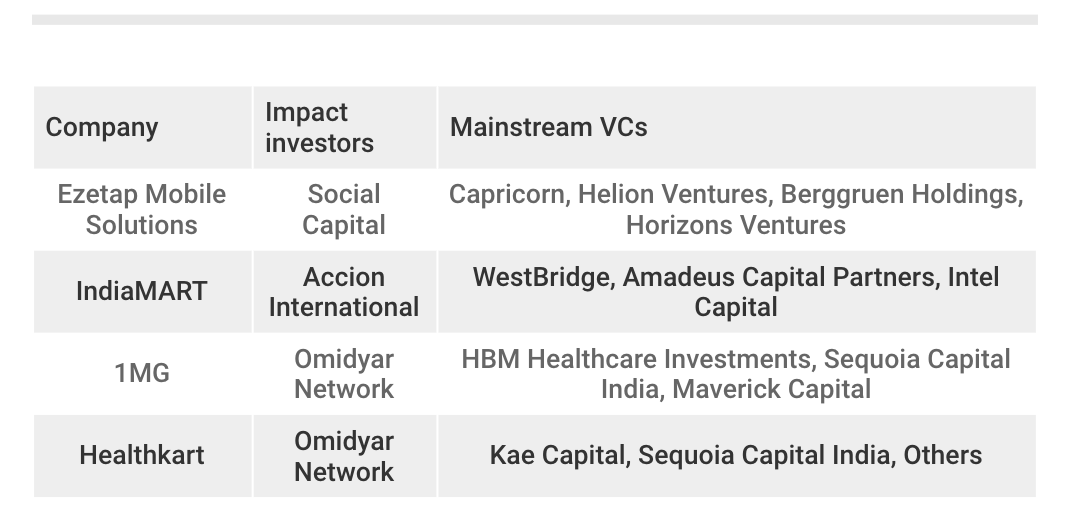
Photo credit: Trocaire.
Recently, Bangalore-based Dunzo, a daily task-management app, raised funds from Aspada, Blume Ventures, and other prominent angel investors like Google’s Rajan Anandan. While Aspada is an impact investor, Blume Ventures happens to be a mainstream investor.
Similarly, RailYatri, a travel app which provides information on trains and passenger amenities, raised funding from Blume Ventures and Helion Venture Partners, both mainstream investors, along with Omidyar Network, an impact investor.
These are just two examples of the blurring boundaries between impact and mainstream venture capital investing. Lately, impact investors are witnessing an increase in interest from traditional investors in the companies on their portfolio.
Gone are the days when doing social good while making money in the process would raise eyebrows. Companies now realize that a positive social impact is only sustainable if the business model is viable. And this has made life easier for VCs, who don’t have to stay away from certain startups.
Radha K, principal at Unitus Seed Fund, prefers to call herself an investor first. “An investor is an investor and I don’t see the need to be classified as a social venture capitalist. Yes, we at Unitus Seed Fund have a goal to create an impact in India by improving the livelihood of the masses, but we are not out there to do charity. As much as we are about impact, we are also about profitability,” says Radha. The phenomenon is especially marked in the consumer internet space.
This has a lot to do with the unique nature of India where a transition is taking place within different strata of society. The underserved population is huge here: and what better way to connect to these people than through the internet?

Source: Venture Intelligence.
Rutvik Doshi, director of Inventus Capital Partners, believes that technology has the power to reach the hinterlands and create a large impact. Since most firms are tech-based today, it is easier for them to reach out to the people who are in the interiors and create an impact by serving the underserved. “In this sense, most companies do create an impact and the lines are blurring. Additionally, these businesses are scalable because of our huge population. So there is something for both impact as well as commercial investors,” says Rutvik.
A case in point is AgroStar, a mobile platform allowing farmers to buy farming equipment either through WhatsApp or through mobile apps. IDG Ventures India (IDGVI) has invested in the startup along with impact investor Aavishkaar. The platform has so far serviced over 150,000 farmers in Gujarat and Maharashtra and is increasing their reach.
Another example is Quikr, an online classifieds platform which has both Omidyar Network, an impact fund, as well as Matrix Partners India as its funders. Tarun Davda, managing director, Matrix Partners India, says online marketplaces create more efficiency which results in job creation and additional income, a factor which appeals to impact investors. “It is a proven business model and hence somebody like us also gets to it.” Similarly, DailyHunt, which provides local language content on the internet has both Omidyar and Matrix as investors.
Karthik Prabhakar, director of IDGVI, agrees with Rutvik on the role of the internet as a far-reaching medium. “Smartphone penetration is fast growing and is enabling the larger population to gain access to jobs, information and markets seamlessly. There is an impact element in everything and returns are there if one finds the right product-market match,” says Karthik.
Higher risk appetite

Photo credit: All What She Wants.
While both kinds of investors look to make financial returns by investing in scalable enterprises, the intention to create social return is what differentiates impact investment,” says Kartik Desai, principal at Asha Impact. He gives the example of how Twitter and Facebook arguably enabled social change during the Arab Spring movement in the Middle East in 2011. But this was not the result of an active intention to create impact but an outcome of their massive scale and ubiquitous reach.
Another interesting differentiation is the ability to take risks when the business model is still not proven. Saurabh Lahoti, who has been associated with several impact funds, says an impact investor is usually an early stage or series-A investor willing to invest in a company if he sees it meeting its impact goals. “The role of an impact investor is to take the early bet and help a company reach a stage where a mainstream investor will be keen to invest in it.”
For Kartik, impact investing is compelling as it allows to find market-based solutions to social problems. “Impact investors take the early stage risks of proving business models that can address poverty. Once these business models demonstrate scalability, it is only natural that they attract commercial capital,” Kartik says.
In India, the microfinance sector is a good example of an area initially nurtured by impact investors.
When the microfinance sector in India started in 2005-06, there were only five interested impact investors. At that stage, no mainstream VC was ready to bet their money on these companies. However, things changed by 2008 and the sector saw the entry of commercial venture capitalists.
Thus, impact investment is generally understood in India to involve for-profit equity or debt investment in early-stage ventures that are delivering basic services to the masses – giving them access to affordable housing, financial services, education, health or energy – or helping them with better livelihood opportunities.
Different for the offline space

Photo credit: Sandeepachetan.
Things are slightly, if not completely, different in the offline space. And the difference is mainly in terms of the pace at which impact is created in the last mile. The impact is far more evident when it comes to internet and mobile startups.
For instance, it is difficult to build a rural school in every small district in India. But it’s possible to create an edtech product which can be leveraged by many, thanks to the growing internet space.
“Fundamentally, you invest in a space you have knowledge in. The internet has the ability to create synergy between rural and technology experts. So you will have a Sequoia who, I believe, is more comfortable with technology companies co-investing with somebody like us who have the knowledge on how the rural market works,” explains Kartik.
This post Impact investing in India is a grey, grey area. Here’s why. appeared first on Tech in Asia.
from Tech in Asia https://www.techinasia.com/impact-investing-india-grey-grey-area-heres
via IFTTT
No comments:
Post a Comment